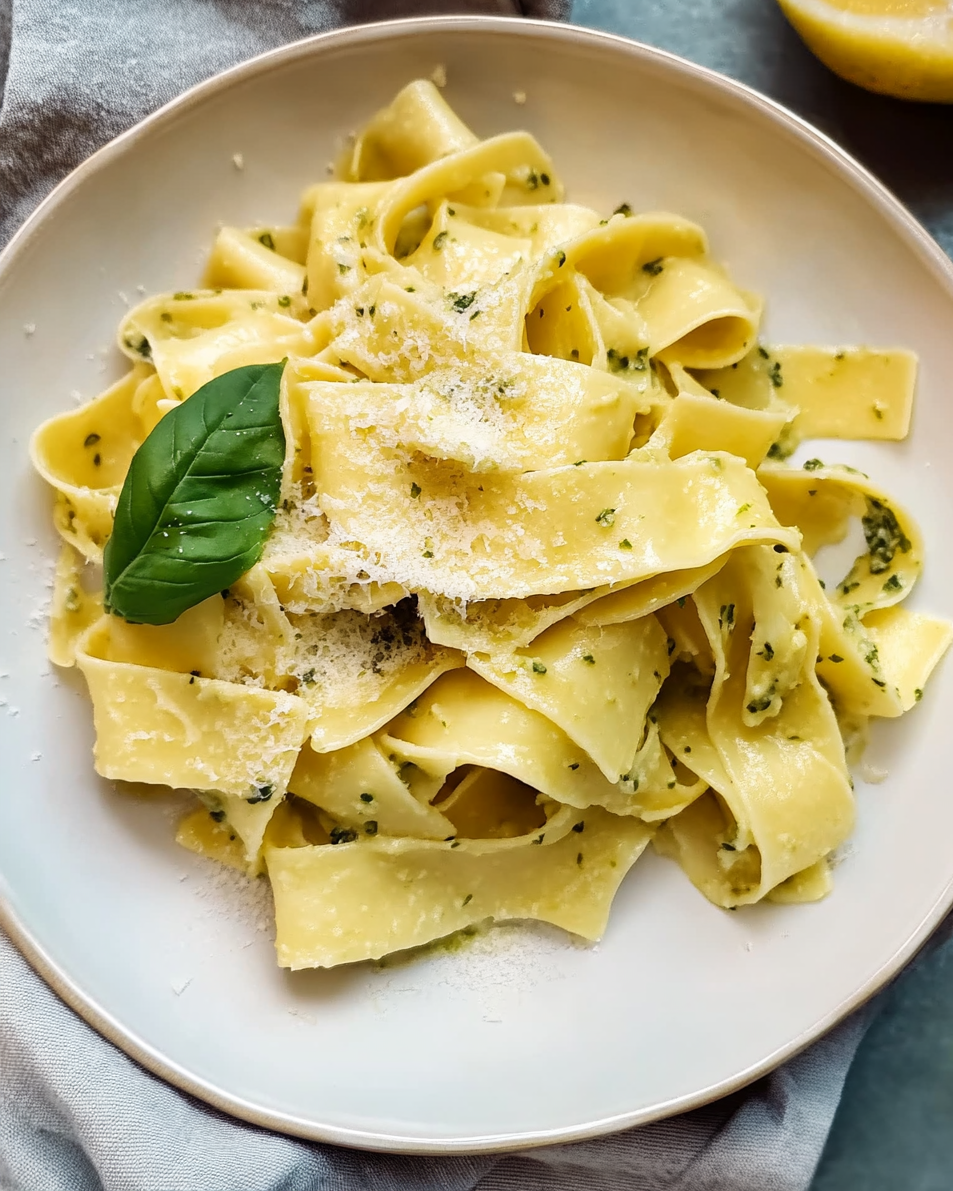Homemade Pappardelle is a beautifully rustic and wide-cut pasta that pairs perfectly with rich, hearty sauces like Bolognese or a creamy mushroom ragù. The dough is made with simple ingredients—just flour, eggs, and olive oil—but the result is a truly luxurious dish that elevates any meal.
Making pasta from scratch can seem intimidating, but this recipe breaks it down into easy-to-follow steps. The fresh pappardelle cooks quickly and delivers a silky, tender texture that store-bought pasta simply can’t match. Whether you’re preparing a special dinner or just craving something homemade, this pappardelle will impress with its fresh, authentic flavor.
Full Recipe:
- 2 cups all-purpose flour
- 3 large eggs
- 1/2 teaspoon salt
- 1 tablespoon olive oil
- 2 tablespoons water, if needed
Directions:
- On a clean surface, make a mound with the flour and create a well in the center.
- Crack the eggs into the well, add salt, and olive oil.
- Slowly whisk the eggs with a fork, gradually incorporating the flour from the edges.
- Once combined, knead the dough for about 8-10 minutes until it becomes smooth and elastic. Add water if the dough is too dry.
- Cover the dough with plastic wrap and let it rest for 30 minutes.
- After resting, roll out the dough on a floured surface until it is very thin, about 1/16 inch.
- Cut the dough into wide strips (pappardelle), about ¾-1 inch in width.
- Boil a large pot of salted water, and cook the pasta for 2-4 minutes, until tender.
- Drain and serve with your favorite sauce.
Prep Time: 15 minutes | Cooking Time: 4 minutes | Total Time: 50 minutes
Kcal: 210 kcal per serving | Servings: 4 servings
What is Pappardelle?
Pappardelle is a traditional Italian pasta, originating from the Tuscany region. It is characterized by its wide, flat ribbons, typically about ¾-1 inch in width. The name “pappardelle” comes from the Italian verb pappare, which means “to gobble up,” perfectly reflecting the pasta’s heartiness and ability to hold up to thick, meaty sauces. Pappardelle is often paired with rich ragùs, such as a classic Bolognese or a slow-cooked rabbit or beef stew. The broad surface of this pasta allows it to soak up and carry flavorful sauces, making each bite rich and satisfying.
Why Make Homemade Pappardelle?
There’s something incredibly special about making your own pasta at home. Unlike store-bought varieties, homemade pappardelle has a tender, silky texture that simply cannot be matched. It’s surprisingly easy to make with just a few pantry staples—flour, eggs, olive oil, and salt. The process of kneading the dough, rolling it out, and cutting the strips by hand brings an authentic Italian experience right into your kitchen.
Additionally, homemade pasta allows for customization. You can adjust the thickness of the noodles, experiment with different types of flour (such as semolina or whole wheat), and even flavor the dough with ingredients like spinach or herbs for added depth and color. It’s an excellent way to elevate any Italian dish you’re serving and impress your guests.
Tips for Perfect Homemade Pappardelle
- Kneading the Dough: Be patient with the dough. Kneading it for about 8-10 minutes will ensure that it becomes smooth and elastic. If the dough feels too dry, don’t hesitate to add a tablespoon or two of water to help bring it together.
- Resting the Dough: Allowing the dough to rest for at least 30 minutes is crucial. This step lets the gluten relax, making it easier to roll out. Skipping this step can result in a tough or hard-to-roll dough.
- Rolling the Dough: To achieve the ideal thinness, roll the dough on a well-floured surface until it’s about 1/16 inch thick. If you’re using a pasta machine, start at the widest setting and gradually work your way down to the thinner settings.
- Cutting the Pasta: Pappardelle is known for its wide shape. Use a sharp knife or a pasta cutter to cut the dough into ¾-1 inch wide strips. For a more rustic feel, don’t worry about making the strips perfectly uniform in size.
- Cooking the Pasta: Fresh pasta cooks much faster than dried pasta. Boil the pappardelle in salted water for just 2-4 minutes, watching carefully to ensure it doesn’t overcook.
Sauce Pairing Suggestions
Pappardelle’s wide shape makes it an ideal pairing for rich, thick sauces that cling to the pasta. Some classic sauces to serve with pappardelle include:
- Bolognese Sauce: A hearty meat sauce made with ground beef, pork, and tomatoes. The richness of the sauce complements the wide, chewy ribbons of pappardelle beautifully.
- Mushroom Ragù: A vegetarian option that uses a variety of mushrooms cooked down with garlic, onions, and wine. The earthy flavors of the mushrooms pair perfectly with the fresh pasta.
- Pesto: For a lighter, herby option, try tossing pappardelle with a fresh basil pesto. The sauce coats the wide noodles and delivers a bright, fresh flavor.
- Butter and Sage: A simple yet classic sauce that consists of melted butter, fresh sage, and a sprinkle of Parmesan. This sauce allows the pasta’s texture and flavor to shine through.
Making it Ahead
Homemade pappardelle can be made ahead of time and stored for future use. After cutting the pasta, you can let it dry on a floured surface for an hour, then carefully roll it into nests and store them in the refrigerator for up to two days or freeze for longer storage. When you’re ready to cook, simply boil the pasta straight from the fridge or freezer.
Nutritional Benefits
While pasta may not be the first thing you think of when considering health-conscious meals, homemade pasta offers the benefit of being free from preservatives and artificial additives. You can also make the dough with whole wheat flour for added fiber and nutrients. Fresh eggs in the dough provide a good source of protein, and by pairing the pasta with vegetable-based sauces or lean proteins, you can create a balanced meal.
The History and Origins of Pappardelle
Pappardelle has deep roots in Italian culinary history, specifically in Tuscany, where the pasta was traditionally made by hand for family gatherings and special occasions. The term “pappardelle” is derived from the verb pappare, an old Italian word that means “to gobble up,” which reflects the indulgent, hearty nature of this pasta. In Tuscany, pappardelle was often served with wild game such as hare, boar, or duck, ingredients that were readily available in the region’s rustic countryside.
Historically, pasta was made using only flour and water in poorer households, with eggs being a luxury ingredient reserved for wealthier families or festive occasions. Today, egg-based pasta like pappardelle is considered a staple of Italian cuisine, often enjoyed as a luxurious comfort food that brings people together over a shared meal.
Why Fresh Pasta is Superior to Store-Bought
There are many reasons why fresh homemade pasta, like pappardelle, stands out compared to store-bought dried pasta:
- Texture: Fresh pasta has a silky, tender texture that dried pasta simply cannot replicate. The eggs in fresh pasta create a rich, smooth dough that cooks quickly and absorbs sauces beautifully.
- Flavor: The fresh ingredients used in homemade pasta contribute to a more pronounced flavor. Pappardelle, made with eggs and flour, offers a subtle richness that enhances the overall taste of the dish.
- Customization: When making pasta from scratch, you can adjust the recipe to fit your dietary needs. For example, you can make gluten-free pappardelle using rice flour or chickpea flour, or add flavorings such as spinach, beets, or squid ink to change the color and taste of the pasta.
- No Additives: Fresh homemade pasta is free of preservatives, artificial colors, or additives that are often found in store-bought varieties. This makes it a healthier and more natural choice for those who prioritize wholesome, minimally processed ingredients.
Tools You’ll Need to Make Homemade Pappardelle
To make the process easier and more enjoyable, here are a few essential tools that can help you make homemade pappardelle:
- Rolling Pin: While you can use a pasta machine, a rolling pin is the traditional tool for rolling out the dough by hand. It requires some elbow grease but gives you more control over the thickness of the pasta.
- Pasta Machine: If you prefer more precision or want to save time, a pasta machine is a great investment. It helps roll the dough to an even thickness and can also be used to cut different types of pasta.
- Dough Scraper: This tool helps to knead and fold the dough, as well as scrape any excess flour or dough off your work surface.
- Kitchen Scale: For accuracy, it’s always a good idea to weigh your ingredients. This is particularly important when making pasta dough, as the ratio of flour to eggs can make or break the texture of the final product.
- Pasta Cutter or Knife: You’ll need a sharp knife or a specific pasta cutter to cut the rolled dough into wide strips for pappardelle.
- Large Pot: A big pot of salted boiling water is key to cooking fresh pasta quickly and evenly. Make sure the pot is large enough to allow the wide pappardelle noodles to move freely as they cook.
Pairing Pappardelle with Wine
Pappardelle is a versatile pasta that pairs well with a wide range of wines. The key is to consider the sauce you’re serving with the pasta:
- For Hearty Meat Sauces: Rich, meaty sauces like Bolognese or wild boar ragù pair best with robust red wines. A Chianti or Sangiovese from Tuscany works perfectly, as their bold tannins and earthy flavors balance the richness of the sauce.
- For Creamy Sauces: If you’re serving pappardelle with a creamy mushroom or Alfredo sauce, opt for a medium-bodied white wine such as a Chardonnay or Pinot Grigio. The acidity of these wines cuts through the creaminess and enhances the flavors of the dish.
- For Pesto or Herb-Based Sauces: Lighter, herb-forward sauces like basil pesto pair well with Sauvignon Blanc or Verdicchio, which have citrusy and herbal notes that complement the freshness of the sauce.
Creative Variations of Pappardelle
Pappardelle is an incredibly adaptable pasta, and there are endless ways to customize it to suit your preferences or dietary needs. Here are a few creative variations you can try:
- Spinach Pappardelle: Add pureed spinach to the dough to create a vibrant green pasta that pairs beautifully with light cream or tomato-based sauces.
- Gluten-Free Pappardelle: Swap out the all-purpose flour for a gluten-free blend or almond flour. Adjust the dough consistency by adding a little extra egg or olive oil to achieve the right texture.
- Beet Pappardelle: For a stunning pink pasta, add cooked and pureed beets to the dough. The sweet, earthy flavor of the beets complements a goat cheese or ricotta-based sauce.
- Herbed Pappardelle: Finely chop fresh herbs like basil, parsley, or thyme and knead them into the dough. This adds a burst of flavor and color to the pasta, making it even more enticing.
- Lemon Pappardelle: For a refreshing twist, add lemon zest to the dough and pair the pasta with a light seafood or butter sauce.
Fun Facts About Pappardelle
- Pappardelle is often made using semolina flour in Italy, which gives the pasta a firmer texture compared to those made with regular wheat flour.
- Traditionally, pappardelle was made by hand without the use of a pasta machine. Cooks would roll out the dough with a rolling pin and use a knife to cut the wide ribbons.
- Pappardelle is often served during festive occasions, particularly around Christmas or Easter in many Italian families, due to its luxurious, rich nature.
- This pasta is sometimes confused with fettuccine or tagliatelle, which are thinner. The key difference lies in the width; pappardelle is much wider, making it ideal for pairing with thick, chunky sauces.
Health Benefits of Homemade Pappardelle
While pasta is often considered a comfort food, homemade versions can offer several nutritional benefits:
- Protein: Fresh pasta made with eggs provides a good amount of protein, which is essential for muscle repair and overall health.
- Energy: The carbohydrates in homemade pasta provide a quick source of energy, making it an excellent choice for athletes or anyone looking for a satisfying meal after a long day.
- Control Over Ingredients: When making pasta from scratch, you have complete control over what goes into the dough. This means you can choose high-quality ingredients, avoid preservatives, and create a dish that aligns with your dietary goals.
Conclusion
Homemade pappardelle is a delightful way to bring authentic Italian cuisine into your kitchen. With just a few simple ingredients and a little time, you can create silky, tender pasta that elevates any meal. Whether paired with a rich ragù or a light herb sauce, this versatile pasta is perfect for impressing guests or enjoying a comforting dinner at home. Once you experience the freshness and flavor of homemade pappardelle, you’ll never want to go back to store-bought pasta again. Happy cooking!






